 Libri di David Nicolle su Unilibro.it) Libri di David Nicolle su Unilibro.it)
|
|
2025 |
 Title :
L'esercito italiano nella prima guerra mondiale
Title :
L'esercito italiano nella prima guerra mondialeAuthor: Nicolle David Publisher: LEG Edizioni Le sfide che il giovane Regno d'Italia dovette affrontare durante la Grande guerra e le difficoltà con cui fu costretto a misurarsi il suo esercito non hanno pari tre le altre nazioni belligeranti. Dal 1915, dopo la sua entrata in guerra contro gli imperi centrali, esso fu duramente impegnato a nord est conto le forze austro-ungariche trincerate sulle montagne e, allo stesso tempo, fu chiamato a operare sui fronti secondari nei Balcani e in Libia. Le ripetute e sanguinose offensive dell'Isonzo culminarono nella rotta di Caporetto, alla quale tuttavia seguì un sorprendente riscatto, fino alla vittoria finale nel 1918. Questo sintetico ma esauriente studio descrive le operazioni condotte dal Regio Esercito italiano e ne illustra organizzazione, uniformi, armamento ed equipaggiamenti, soffermandosi anche sulle celebri 'compagnie della morte' e sul reparto d'assalto degli Arditi. € 18,00
|
|
|
2024 |
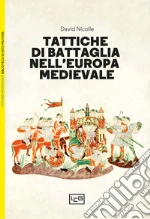 Title :
Tattiche di battaglia nell'Europa medievale
Title :
Tattiche di battaglia nell'Europa medievaleAuthor: Nicolle David Publisher: LEG Edizioni Osservando i diversi sviluppi delle tattiche europee altomedievali, ben lontane dall'assomigliare al caos indisciplinato che in genere si immagina, risultano ben chiari il declino della cavalleria nei regni 'barbari' che sostituirono l'Impero romano d'Occidente e la sua sopravvivenza negli eserciti misti bizantini. Altre tradizioni militari, provenienti dalle steppe eurasiatiche e dal mondo islamico, influenzarono le tattiche europee, dove l'importanza di forze bilanciate di cavalleria e fanteria rimase fondamentale. Con la successiva evoluzione degli eserciti professionisti, le tattiche sul campo di battaglia e i modi in cui i sovrani potevano affrontare le guerre variarono a seconda dei metodi di reclutamento e dell'equipaggiamento. Le truppe arruolate dalle città-stato italiane erano diverse da quelle di Stati nazione emergenti come Inghilterra e Francia. Mentre forze equilibrate di fanteria, cavalleria pesante e leggera erano necessarie ovunque, la guerra nell'Europa occidentale e centrale era differente da quella fra cristiani e musulmani in Spagna, e dagli scontri sulle frontiere orientali della cristianità. Il testo, corredato da rare testimonianze nonché esplicativi piani di battaglia, è illustrato con scenari a colori che riportano in vita alcuni scontri importanti. € 22,00
Scontato: € 20,90
|
|
|
2023 |
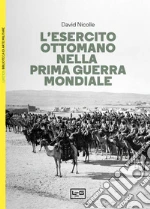 Title :
L'esercito ottomano nella prima guerra mondiale
Title :
L'esercito ottomano nella prima guerra mondialeAuthor: Nicolle David Publisher: LEG Edizioni L'impero turco ottomano fu uno dei grandi protagonisti della Prima guerra mondiale. Il valore dei suoi soldati fu riconosciuto da tutti, eppure l'esercito in cui essi prestarono servizio è in genere poco conosciuto. Nei cinque anni della Grande Guerra, l'esercito, la marina e due esigui corpi aerei combatterono su cinque fronti principali, senza dimenticare i reparti impegnati in altri teatri operativi. Questo volume prende in esame l'organizzazione, le uniformi e l'equipaggiamento dell'esercito ottomano durante questo periodo, e sfata i numerosi miti presenti nei lavori di ricerca apparsi fino a oggi. € 18,00
Scontato: € 17,10
|
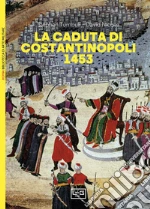 Title :
La caduta di Costantinopoli 1453
Title :
La caduta di Costantinopoli 1453Author: Turnbull Stephen; Nicolle David Publisher: LEG Edizioni Il libro presenta due aspetti chiave della storia di Costantinopoli e dell'Impero bizantino: dopo una prima parte dedicata all'analisi minuziosa del sistema di fortificazioni della capitale, una seconda segue le ultime tappe che condussero gli ottomani alla conquista della città nel 1453, segnando la fine di un impero che era durato oltre mille anni. Un fondamentale scontro della storia viene ripercorso nel dettaglio delle strategie, delle tattiche, delle forze in campo e degli armamenti, con l'ausilio di un ricco apparato di illustrazioni e mappe che completano le illuminanti informazioni testuali. € 28,00
Scontato: € 26,60
|
|
1919 |
 Title :
Cross & Crescent in the Balkans
Title :
Cross & Crescent in the BalkansAuthor: David Nicolle Publisher: PEN & SWORD BOOKS € 20,50
|
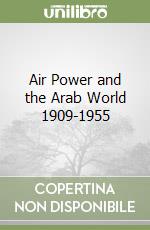 Title :
Air Power and the Arab World 1909-1955
Title :
Air Power and the Arab World 1909-1955Author: Dr David C Nicolle Publisher: Helion & Company Limited € 26,80
|
|
2018 |
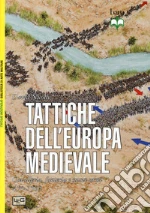 Title :
Tattiche dell'Europa medievale. Cavalleria, fanteria e nuove armi 450-1500
Title :
Tattiche dell'Europa medievale. Cavalleria, fanteria e nuove armi 450-1500Author: Nicolle David Publisher: LEG Edizioni Questo libro spiega i diversi sviluppi delle tattiche europee altomedievali, ben lontane dall'assomigiiare al caos indisciplinato che in genere sì immagina. Tratteggia il declino della cavalleria come arma vincente in battaglia nei regni 'barbari' che sostituirono l'impero romano d'Occidente, e la sua sopravvivenza negli eserciti misti dell'impero bizantino. Segue poi la rinascita della cavalleria e della fanteria a cavallo sotto i carolingi nel IX-X secolo, quando vennero minacciate dagli invasori a cavallo e che giungevano via mare, fino allo sviluppo della cavalleria normanna munita di armatura. L'autore spiega come altre tradizioni militari, provenienti dalle steppe eurasiatiche e dal mondo islamico, influenzarono le tattiche europee, e sottolinea l'importanza di forze bilanciate di cavalleria e fanteria in quasi ogni situazione. L'autore descrive poi il percorso dagli eserciti in sostanza feudali a quelli pressoché del tutto professionisti. I metodi con cui venivano reclutati e pagati ne determinavano il livello dell'equipaggiamento e delle capacità, e di conseguenza le tattiche sul campo di battaglia e i modi in cui i sovrani potevano affrontare le guerre. Le truppe arruolate da piccole ma ricche città-Stato italiane erano molto diverse da quelle di Stati-nazione emergenti come l'Inghilterra e la Francia, o del Sacro Romano Impero. Mentre forze equilibrate di fanteria, cavalleria pesante e leggera erano necessarie quasi ovunque, la guerra nell'Europa occidentale e centrale era diversa da quella fra cristiani e musulmani in Spagna, e dalle guerre sulle frontiere orient € 15,00
|
|
|
1917 |
 Title :
Wings over Sinai
Title :
Wings over SinaiAuthor: Nicolle David, Cooper Tom, Gabr Ali Gabr Publisher: Helion & Co Ltd € 31,20
|
|
|
1916 |
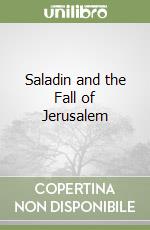 Title :
Saladin and the Fall of Jerusalem
Title :
Saladin and the Fall of JerusalemAuthor: Lane-Poole Stanley, Nicolle David (INT) Publisher: Frontline Books € 17,90
|
|
|
1914 |
 Title :
Mamluk Askari 1250-1517
Title :
Mamluk Askari 1250-1517Author: Nicolle David, Dennis Peter (ILT) Publisher: Osprey Pub Co New archaeological material and research underpin this extensive, detailed and beautifully illustrated account of the famous Mamluk Askars.The Mamluk army is credited with finally defeating and expelling the Crusaders from the Middle East, with defeating and halting the Mongol invasion of the Islamic Middle East, and with facing down - though not defeating - Tamerlane. Their state was an essentially military one but was for centuries also the Protector of the Holy Places, which gave it supreme prestige within the later medieval Islamic world.The mamluk troops (askaris) of the Mamluk Sultanate in Egypt and Syria were probably the ultimate professional soldiers of the medieval period. They were supposedly recruited as adolescent slaves, though recent research has begun to undermine this oversimplified interpretation of what has been called the 'mamluk phenomenon'.The Mamluk Sultanate and its army lasted for a remarkably long time, from the mid-13th to early 16th century, long enough to resist the Portuguese in the Indian Ocean and Red Sea, before finally being defeated and overthrown by the Ottoman Sultanate. Indeed the mamluk phenomenon lasted even longer in Ottoman-ruled Egypt, until the final years of the 18th century. It was so embedded in Egyptian, and to a lesser extent Syrian, society and politics that the modern Egyptian army of the 19th century has, during its first decades, been described as a neo-mamluk force. € 14,20
|
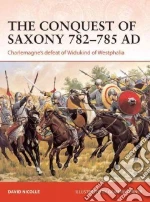 Title :
The Conquest of Saxony Ad 782-785
Title :
The Conquest of Saxony Ad 782-785Author: Nicolle David, Turner Graham (ILT) Publisher: Osprey Pub Co Charlemagne's conquests became the driving force in European politics between the Muslim defeat at Poitiers and the Crusades. He dominates the military history of Medieval Europe since his empire spanned France, western Germany, and northern Italy. Charlemagne's conquest of the Saxons was the hardest fought and most protracted of his wars. It involved 18 campaigns spread over 33 years, a great deal of lower-level fighting and the harshest final peace settlement that Charlemagne ever imposed upon a defeated foe. This was also the most important of all Charlemagne's war for the future direction and character of European history and, paradoxically, it also began the long process of uniting the German-speaking peoples. Starting in 772 with a series of raids and incursions, the Carolingian campaign rapidly took on the character of a religious conquest, and may well have been the inspiration for the later crusades against both Islam and pagan peoples of Prussia and Livonia. Following a series of revolts and uprisings under the popular Saxon leader Widukind, Charlemagne took the field personally in the years 782 to 785 and, through a series of pitched battles and smaller actions before finally brining Widukind to heel in 785, consolidating Saxony as part of the greater Carolingian Empire. € 19,60
|
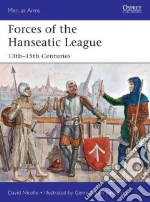 Title :
Forces of the Hanseatic League
Title :
Forces of the Hanseatic LeagueAuthor: Nicolle David, Embleton Gerry (ILT), Embleton Sam (ILT) Publisher: Osprey Pub Co The famous but largely unchronicled Hanseatic League (or simple 'the Hanse/Hansa') was a Tuetonic German commercial and defensive federation of merchant guilds based in harbor towns along the North Sea and Baltic coasts of what are now Germany and her neighbors, which eventually dominated maritime trade in Northern Europe and spread its influence much further afield. The League was formed to protect the economic and political interests of member cities throughout a vast and complex trading network. While most members remained basically subject to the local rulers who profited from their prosperity, in a sense the League might be seen as foreshadowing today's ambiguous relationship between global corporations and political nation states. The League continued to operate well into the 17th century, but its golden age was between c. 1200 and c. 1500; thereafter it failed to take full advantage of the wave of maritime exploration to the west, south and east of Europe. During its 300 years of dominance the League's large ships - called 'cogs' - were at the forefront of maritime technology, were early users of cannon, and were manned by strong fighting crews to defend them from pirates in both open-sea and river warfare. The home cities raised their own armies for mutual defence, and their riches both allowed them, and required them, to invest in fortifications and gunpowder weapons, since as very attractive targets they were subjected to sieges at various times. € 16,10
|
|
2014 |
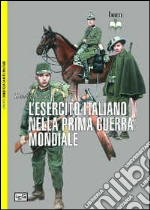 Title :
L'esercito italiano nella prima guerra mondiale
Title :
L'esercito italiano nella prima guerra mondialeAuthor: Nicolle David Publisher: LEG Edizioni € 15,00
|
|
|
1913 |
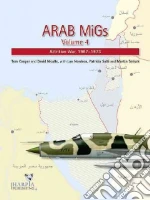 Title :
Arab Migs
Title :
Arab MigsAuthor: Cooper Tom, Nicolle David, Nordeen Lon (CON), Salti Patricia (CON), Smisek Martin (CON) Publisher: Harpia Pub Llc € 60,10
|
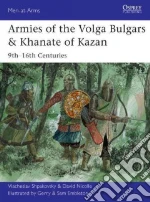 Title :
Armies of the Volga Bulgars & Khanate of Kazan
Title :
Armies of the Volga Bulgars & Khanate of KazanAuthor: Shpakovsky Viacheslav, Nicolle David, Embleton Gerry (ILT), Embleton Sam (ILT) Publisher: Osprey Pub Co Facing off against Byzantines, Arabs, Vikings, Turks, Mongols, and Russians, this steppe culture dominated Black Sea and Caucasus trade during Medieval times. The Bulgars were a Turkic people who established a state north of the Black Sea, and who showed similarities with the Alans and Sarmatians. In the late 500s and early 600s AD their state fragmented under pressure from the Khazars; one group moved south into what became Bulgaria, but the rest moved north during the 7th and 8th centuries to the basin of the Volga river. There they remained under Khazar domination until the Khazar Khanate was defeated by Kievan (Scandinavian) Russia in 965. Thereafter the Volga Bulgars - controlling an extensive area surrounding an important hub of international trade - became richer and more influential; they embraced Islam, becoming the most northerly of medieval peoples to do so. Given their central position on trade routes, their armies were noted for the splendour of their armour and weapons, which drew upon both Western and Eastern sources and influences (as, eventually, did their fighting tactics). In the 1220s they managed to maul Genghis Khan's Mongols, who returned to devastate their towns in revenge. By the 1350s they had recovered much of their wealth, but they were caught in the middle between the Tatar Golden Horde and the Christian Russian principalities. They were ravaged by these two armies in turn on several occasions between 1360 and 1431. A new city then rose from the ashes - Kazan, originally called New Bulgar - and the successor Islamic Khanate of Kazan resisted the Russians until falling to Ivan the Terrible in 1552. The costumes, armament, armour and fighting methods of the Volga Bulgars during this momentous period are explored in this fully illustrated study. € 17,00
|
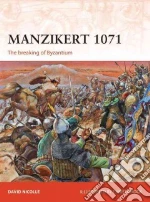 Title :
Manzikert 1071
Title :
Manzikert 1071Author: Nicolle David, Hook Christa (ILT) Publisher: Osprey Pub Co On 26 August 1071 a large Byzantine army under Emperor Romanus IV met the Saljuq Turk forces of Sultan Alp Arslan near the town of Manzikert to the far east of the Byzantine Empire. The battle ended in a decisive defeat for the Byzantine forces, with the wings of the army routing following withering Turkish arrow fire, and the centre overwhelmed, with the Byzantine emperor captured and much of his fabled Varangian guard killed. This battle is justifiably regarded as a turning point in Middle Eastern, European and to some extent even world history. It is seen as the primary trigger of the Crusades, and as the moment when the power of the East Roman or Byzantine Empire was irreparably broken. The Saljuq victory opened up Anatolia to Turkish-Islamic conquest, which was eventually followed by the establishment of the Ottoman state which went on the conquer south-eastern and much of central Europe, the entire Middle East and most of North Africa. Nevertheless the battle itself was the culmination of a Christian Byzantine offensive, intended to strengthen the eastern frontiers of the empire and re-establish Byzantine domination over Armenia and northern Mesopotamia. Turkish Saljuq victory was in no sense inevitable and might, in fact, have come as something of a surprise to those who achieved it - at least in proving to be so complete. It was not only the battle of Manzikert that had such profound and far-reaching consequences, many of these stemmed from the debilitating Byzantine civil war which followed and was a direct consequence of the defeat. € 20,30
|
|
2013 |
 Title :
Tattiche dell'Europa medievale. Cavalleria, fanteria e nuove armi 450-1500
Title :
Tattiche dell'Europa medievale. Cavalleria, fanteria e nuove armi 450-1500Author: Nicolle David Publisher: LEG Edizioni Questo libro spiega i diversi sviluppi delle tattiche europee altomedievali, ben lontane dall'assomigiiare al caos indisciplinato che in genere sì immagina. Tratteggia il declino della cavalleria come arma vincente in battaglia nei regni 'barbari' che sostituirono l'impero romano d'Occidente, e la sua sopravvivenza negli eserciti misti dell'impero bizantino. Segue poi la rinascita della cavalleria e della fanteria a cavallo sotto i carolingi nel IX-X secolo, quando vennero minacciate dagli invasori a cavallo e che giungevano via mare, fino allo sviluppo della cavalleria normanna munita di armatura. L'autore spiega come altre tradizioni militari, provenienti dalle steppe eurasiatiche e dal mondo islamico, influenzarono le tattiche europee, e sottolinea l'importanza di forze bilanciate di cavalleria e fanteria in quasi ogni situazione. L'autore descrive poi il percorso dagli eserciti in sostanza feudali a quelli pressoché del tutto professionisti. I metodi con cui venivano reclutati e pagati ne determinavano il livello dell'equipaggiamento e delle capacità, e di conseguenza le tattiche sul campo di battaglia e i modi in cui i sovrani potevano affrontare le guerre. Le truppe arruolate da piccole ma ricche città-Stato italiane erano molto diverse da quelle di Stati-nazione emergenti come l'Inghilterra e la Francia, o del Sacro Romano Impero. Mentre forze equilibrate di fanteria, cavalleria pesante e leggera erano necessarie quasi ovunque, la guerra nell'Europa occidentale e centrale era diversa da quella fra cristiani e musulmani in Spagna, e dalle guerre sulle frontiere orient € 15,00
|
|
|
1912 |
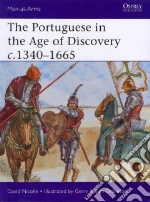 Title :
The Portuguese in the Age of Discoveries c. 1340-1665
Title :
The Portuguese in the Age of Discoveries c. 1340-1665Author: Nicolle David, Embleton Gerry (ILT), Embleton Sam (ILT) Publisher: Osprey Pub Co From humble beginnings, in the course of three centuries the Portuguese built the world's first truly global empire, stretching from modern Brazil to sub-Saharan Africa and from India to the East Indies (Indonesia). Portugal had established its present-day borders by 1300 and the following century saw extensive warfare that confirmed Portugal's independence and allowed it to aspire to maritime expansion, sponsored by monarchs such as Prince Henry the Navigator. Intent on finding a sea route to the source of the lucrative spice trade, the Portuguese discovered a route down Africa's western coast, employing the innovative caravel, a vessel that could be sailed closer to the wind than any other in use at the time. In 1488 Bartolomeu Dias rounded the Cape of Good Hope and ten years later Vasco da Gama reached India. In 1500 Pedro Álvares Cabral discovered Brazil and the Portuguese began to exploit the fabulous natural wealth of the Americas. Victory over the Mamluks at the Battle of Diu (1509) handed the Portuguese control over the Indian Ocean and allowed them to capture a succession of key ports such as Ceylon, Goa and Malacca. Portuguese sailors continued to explore the coasts and islands of East Asia, and by 1580 a network of outposts linked Lisbon to a vast trading empire that stretched as far as Japan. The period closed with Portugal and its empire passing to Spanish control for 60 years from 1580. During this nearly 300-year period, the Portuguese fought alongside other Iberian forces against the Moors of Andalusia; with English help successfully repelled a Castilian invasion (1385); and fought the Moors in Morocco, Africans, the Ottoman Turks, and the Spanish in colonial competition. The colourful and exotic Portuguese forces that prevailed in these battles on land and sea are the subject of this book. € 16,10
|
 Title :
Arab Migs
Title :
Arab MigsAuthor: Cooper Tom, Nicolle David, Nordeen Lon, Salti Patricia Publisher: Harpia Pub Llc € 60,10
|
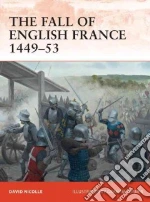 Title :
The Fall of English France 1449-53
Title :
The Fall of English France 1449-53Author: Nicolle David, Turner Graham (ILT) Publisher: Osprey Pub Co For the overwhelming majority of people outside the French-speaking world the Hundred Years War consisted of a sequence of major English victories, above all Crécy, Poitiers and Agincourt. The only significant victor or 'hero' on the French side was Joan of Arc, and she ended up being burned at the stake. Yet somehow the war ended in a French victory and with England's martial energies being turned against itself in the Wars of the Roses. This book is intended to provide some balance. It will describe the campaign that brought the Hundred Years War to a close, with English possessions being confined to Calais and the Channel Islands. It will also explain how the somewhat unprepossessing and unmartial King Charles VII of France succeeded where his predecessors had failed. The campaign consisted of more than battles, of course, but it was marked by two major victories - at Formigny in 1450 and at Castillon in 1453. Formigny is of special interest because it saw French cavalry defeat English archers, in effect a reversal of Crécy, Poitiers and Agincourt, and could be interpreted as one of the last 'medieval' battles. Castillon is of interest because it was a victory of gunpowder artillery in fixed positions over a traditional medieval assault by mixed infantry and cavalry, and thus could be interpreted as one of the first 'modern' battles. € 20,30
|
|
1911 |
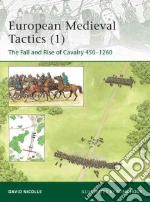 Title :
European Medieval Tactics 1
Title :
European Medieval Tactics 1Author: Nicolle David, Hook Adam (ILT) Publisher: Osprey Pub Co Osprey's elite title on the rise and fall of European medieval cavalry during an 800 year period. After the fall of the Western Roman Empire there was a decline in professional cavalry forces, and infantry dominated in the Germanic successor barbarian kingdoms. In the Carolingian and Norman periods from the 9th to the 11th centuries, under the impact of Viking, Saracen and Magyar advances, the cavalry arm gradually expanded from the small remaining aristocratic elite. Even so, the supposedly complete dominance of the knight in the 12th and 13th centuries is grossly exaggerated, as integrated cavalry and infantry tactics were nearly always the key to success. This is the first in a two-part treatment of medieval tactics, covering developments in both cavalry and infantry tactics. Throughout the period there was a steady evolution of training in both individual and unit skills, of armor and weapons, and thus of tactics on the battlefield. This book covers key moments in this story of evolution from Hastings in 1066 to Legnano in 1176. It also details the later development of cavalry versus cavalry tactics and the two key set piece battles of Bouvines in 1214 and Pelagonia in 1259, the former an example of abject failure of cavalry tactics and the latter a stunning success. € 17,00
|
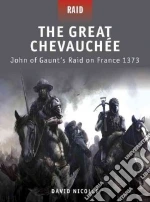 Title :
The Great Chevauchee
Title :
The Great ChevaucheeAuthor: Nicolle David, Dennis Peter (ILT), Spedaliere Donato (ILT), Kozik Mariusz (ILT) Publisher: Osprey Pub Co In 1373, John of Gaunt set off from Calais on a great raid to strike at the heart of France. Driven by the high ideals of chivalry, the raiders left with epic pageantry. However, the reality soon overwhelmed the raiders. Beset on all sides by French ambushes and plagued by disease and starvation, the raiders battled their way through Champagne, east of Paris, into Burgundy, across the Massif Central and finally down into the Dordogne. Unable to attack any major fortifications, John of Gaunt's men plundered the countryside, raiding towns and villages, weakening the French infrastructure. While the military value of the raid is debatable, the English knights who finally made it home were hailed as heroes. This book charts the course of the raid from beginning to end, studying all the battles and skirmishes the raiders fought along the way in this bloody example of chivalric warfare. € 17,60
|
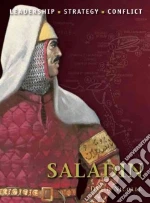 Title :
Saladin
Title :
SaladinAuthor: Nicolle David, Dennis Peter (ILT) Publisher: Osprey Pub Co This Osprey Command book looks closely at the early life, military experiences and key battlefield exploits of Al-Malik al-Nasir Yusuf Ibn Najm al-Din Ayyub Ibn Shahdi Abu'l-Muzaffar Salah al-Din - or Saladin as he is more commonly known outside the Islamic world - who is broadly regarded as the greatest hero of the Crusades, even in Europe. Most chroniclers present him as a man of outstanding virtue, courage and political skill. More recently, however, efforts have been made to portray Saladin as an ambitious, ruthless and even devious politician, and as a less brilliant commander than it normally thought. This book sets out to reveal that the truth is, as usual, somewhere in between. € 17,00
|
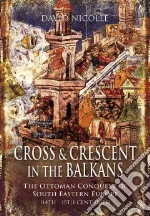 Title :
Cross and Crescent in the Balkans
Title :
Cross and Crescent in the BalkansAuthor: Nicolle David Publisher: Pen & Sword € 37,00
|
||
|
2009 |
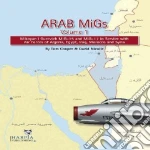 Title :
Arab Migs
Title :
Arab MigsAuthor: Cooper Tom, Nicolle David Publisher: Harpia Pub Llc € 60,10
|
 Title :
Saracen Strongholds 1100-1500
Title :
Saracen Strongholds 1100-1500Author: Nicolle David, Hook Adam (ILT) Publisher: Osprey Pub Co By the time of the Crusades, the Islamic world had developed its own sophisticated styles of fortification. Distinctive and highly effective, the region's unique military architecture continued to evolve in response to the Crusader and Mongol threats, and also drew upon the traditions of their foes and neighbors. The resulting Islamic concepts of military architecture had an influence upon fortifications in Western Europe, including Italy and the Iberian Peninsula. Rather than providing security for feudal aristocracies, however, as was increasingly the case in Europe, Islamic fortifications continued to focus upon the defence of cities and frontiers Covering fortifications as far apart as North Africa, Afghanistan and northern India, this volume focuses on the Islamic side of the conflict, highlighting the fortifications in use when the Crusaders sought to reconquer the Holy Land, as well as the eventual absorption of the territories of Byzantium into the Islamic world. € 17,00
|
 Title :
The Great Islamic Conquests AD 632-750
Title :
The Great Islamic Conquests AD 632-750Author: Nicolle David Publisher: Osprey Pub Co Few, if any, centuries in world history have had such a profound and long-lasting impact as the first hundred years of Islamic history. In this book, David Nicolle, a former member of the BBC's Arabic service, examines the extensive Islamic conquests between 632 and 750 AD. These years saw the religion and culture of Islam, as well as the Arabic language, erupt from the Arabian Peninsula to spread across an area far larger than that of the Roman Empire at its greatest extent. It also saw the abrupt collapse of the Persian Empire, as well as the permanent withdrawal of the Romano-Byzantine Empire and its associated cultures, along with Christianity as a ruling faith, from the Middle East and North Africa. Virtually all the lands "opened" by their armies remain Islamic - and in many cases Arabic-speaking - to this day, in contrast to the often ephemeral achievements of better-known conquerors, such as Alexander the Great and several Roman Caesars, and the effects of this rapid expansion was to shape European affairs for centuries to come. € 18,50
|
 Title :
The Second Crusade 1148
Title :
The Second Crusade 1148Author: Nicolle David, Hook Christa (ILT) Publisher: Osprey Pub Co After the fall of the crusader kingdom of Edessa, the Pope called for a new crusade in 1145. This new campaign by the Christian west against the forces of eastern Islam would culminate in the 1148 siege of Damascus, then the capital city of an Islamic state that had been friendly towards the crusaders. Despite the earlier successes for the crusaders at Antioch and Jerusalem, and the weak fortifications around Damascus, the siege proved a dismal and embarrassing failure for the western armies. The siege was abandoned soon after it had started and the crusaders retreated. This defeat shocked the Christian world and dealt a severe blow to the confidence of the crusading armies, while bolstering the morale of their enemies. € 20,30
|
||
|
2008 |
 Title :
Saracen Strongholds AD 630-1050
Title :
Saracen Strongholds AD 630-1050Author: Nicolle David, Hook Adam (ILT) Publisher: Osprey Pub Co The Islamic world developed its own highly sophisticated, effective and varied style of fortification. It drew upon pre-existing Romano-Byzantine, Iranian, Central Asian and Indian traditions of military architecture, plus influences from China, to produce something new and distinctive. In turn, Islamic concepts of military architecture influenced fortifications throughout the Byzantine Empire and, to an even greater extent, in Western Europe. One key point of distinction with the latter in particular was that Islamic fortifications were primarily focussed upon defending cities and frontiers, rather than being associated with royal and feudal elites, as was the case in most of Europe. Despite this highly practical role, medieval Islamic military architecture went beyond the merely functional, and the finest surviving examples are imbued with a sense of symbolic magnificence. This title, the first of several proposed volumes in the Fortress series, takes a look at early Islamic fortifications in the central and eastern lands. It covers the historical background, socio-political circumstances, and purposes of early military architecture; the incorporation of several different traditions and the development of a distinctive character; and the fortifications' role in protecting industry, trade and the frontiers of the Islamic world. Subsequent volumes will deal with the 12th to 16th centuries in the center and east, and the western Islamic lands of North Africa and the Iberian Peninsula, respectively. € 17,00
|
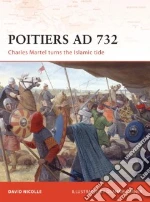 Title :
Poitiers AD 732
Title :
Poitiers AD 732Author: Nicolle David, Turner Graham (ILT) Publisher: Osprey Pub Co In the early decades of the 8th century AD, Islamic forces were flooding into Europe through the Iberian peninsula, threatening Frankish and Burgundian territory and raiding it with ever-increasing ferocity. At the battle of Poitiers, also known as Tours, Christian forces under the Frankish leader Charles Martel "The Hammer" (grandfather of Charlemagne) confronted a massive invading Islamic army. The Franks were victorious, effectively halting the northward advance of Islam and preserving Christianity as the dominant faith in Europe. Expert medievalist David Nicolle draws on contemporary sources to reconstruct this turning-point battle, places it in its historical context and reviews its background and immediate and longer-term historical consequences. € 20,30
|

|

|

|